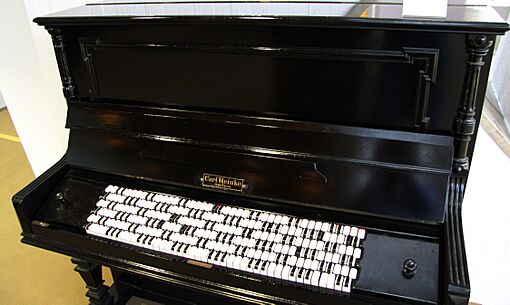Jankó keyboard facts for kids
The Jankó keyboard is a special type of musical keyboard for pianos. It was invented in 1882 by Paul von Jankó, a Hungarian musician and engineer. He designed it to fix some problems with regular piano keyboards. For example, it can be hard for pianists with small hands to reach wide notes (like an octave or ninth). Also, on a normal piano, you have to use different finger patterns for each scale.
The Jankó keyboard looks very different! Instead of one row of keys, it has six rows. Imagine two sets of keys, one fitting into the other, with three places to press for each note. This creates six rows of keys. If you look at a column of three keys going up and down, each one is a semitone (the smallest step in music) away from the next. But if you play notes along a single row, each note is a whole step (two semitones) away from the one before it.
Contents
How the Jankó Keyboard Works
This unique design means that every chord and scale feels the same on the keyboard, no matter what key you are playing in. This is a big help because it means you don't have to learn new finger patterns when you change the key of a song.
The many rows also help your hand feel more natural as you play, since your fingers are different lengths. The keyboard still uses the familiar colors of a regular piano, with white keys for natural notes and black keys for sharps and flats. This helps students learn.
For a full-size piano with 88 notes, a Jankó keyboard would have 264 keys in total. This is because each note can be played by three keys that are lined up vertically. Even with all these keys, the Jankó keyboard is only 89 cm (35 in) wide, which is much narrower than a standard 123 cm (48 in) keyboard. The smaller key size also makes it easier to reach wider musical intervals.
History and Impact
When the Jankó keyboard was invented, it caused a lot of excitement. People were impressed by its unique look and clever design. Around 1891, an American piano company called Decker Brothers started making pianos with this keyboard. A music school called the Paul de Janko Conservatory of Music even opened in New York at that time. There was even a book written by W. Bradley Keeler called How to Play the New Keyboard to help people learn.
Why It Didn't Become Popular
Despite all the early interest, the Jankó keyboard never became widely popular. There were a few reasons for this:
- Music teachers weren't convinced: Many music teachers felt that the benefits of the new keyboard weren't enough to make people switch from the traditional one.
- Musicians didn't want to relearn: Most performers didn't want to spend time learning all their music again on a completely different keyboard with new finger patterns.
- Manufacturers were worried: Piano makers were afraid to invest money in building a new type of keyboard that might not sell well.
Similar Keyboard Designs
Even though the original Jankó keyboard didn't become famous, many other inventors have created similar keyboard designs over the years. Jankó himself changed the shape of his keys a few times. Other inventors have filed patents for keyboards that are very much like his, often changing the key shape or the instrument they are attached to.
Here are some examples of similar designs:
- John Trotter, English Patent 3404, 1811
- William A. B. Lunn (under the name Arthur Wallbridge), 1843
- Miguel Theodore de Folly, Useful Registered Design Number 448, 1845
- Gould and Marsh, US patent no. 24021, 1859
- Edgar, US patent no. 119335, 1871
- Cramer, US patent no. 152726, 1874
- McChesney, US patent no. 161806, 1875
- Stewart, US patent no. 334484, 1886
- Adams, US patent no. 682014, 1901
- Nordbö, US patent no. 1202882, 1916
- Barnett, US patent no. 1958227, 1934
- Reuther, US patent no. 2203393, 1940
- Firestone, US patent no. 2417639, 1945
See also
 In Spanish: Teclado Jankó para niños
In Spanish: Teclado Jankó para niños
- Isomorphic keyboard
- Generalized keyboard



